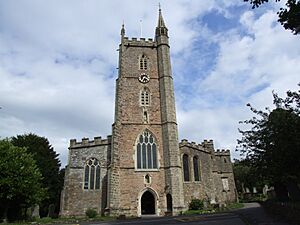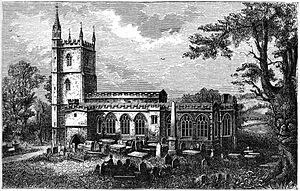Holy Trinity Church, Westbury on Trym facts for kids
Quick facts for kids Holy Trinity Church |
|
|---|---|

The church tower.
|
|
| Religion | |
| Affiliation | Church of England |
| District | Westbury-on-Trym |
| Ecclesiastical or organizational status | Parish church |
| Location | |
| Location | Bristol, England |
| Architecture | |
| Architectural style | English Gothic |
| Completed | 15th century |
| Website | |
| Holy Trinity | |
Holy Trinity Church is a special church in Westbury-on-Trym, a part of Bristol, England. It belongs to the Church of England.
The very first church here was built a long, long time ago, in the 700s. Later, in the 900s, a Benedictine priory, which is like a monastery, was started. The church building you see today began to be built in the early 1200s. It has been changed and rebuilt many times since then.
This church is very important. Historic England has given it a special status called "Grade I listed building." This means it's a building of great historical and architectural importance. For many years, from the late 1100s to the mid-1500s, it was a "collegiate church." This means it was connected to a college called Westbury College. Today, only a small part of the college, like its gatehouse, is still standing.
Inside the church, you can find the tomb of John Carpenter, who was a bishop. He had big plans for this church, hoping to make it a joint cathedral for his area.
Contents
The Church's Long History
How the Church Began
People used to think the first church was built around 716-717. But records show that other churches were built then, not this one. Still, we know a church was definitely here by the late 700s. King Offa of Mercia started a "minster" (a type of church) on this spot between 793 and 796.
This minster became a Benedictine priory around 963-964. This was part of a big change by Bishop Oswald of Worcester. He wanted to bring the "Rule of Saint Benedict" (a set of rules for monks) to his churches. He even brought a monk named Germanus from a famous abbey in France to be the new leader. However, Bishop Oswald soon moved the monks to a new place called Ramsey. The old priory buildings here then fell apart. Around 1093, Bishop Wulfstan got the ruined priory back and rebuilt it as a monastery.
Becoming a Collegiate Church
For about 100 years, monks and other priests kept taking turns owning the monastery. Finally, around 1194, it was decided that regular priests would run the church. This is when it became a "collegiate church." The priests, called canons, were supported by money from different areas around Westbury-on-Trym. These areas included Aust, Henbury, and Lawrence Weston.
A famous thinker named John Wycliffe was one of the canons here from 1362 until he passed away in 1384. He was known for wanting to reform the church. However, in 1367, he was told he wasn't doing his job because he was away for so long. Another important person, William Canynge, who was a rich merchant from Bristol, became the dean (leader) of the college from 1469 until he died in 1474.
In 1544, during a time called the Dissolution of the Monasteries, the church changed again. It became a regular parish church within the new Diocese of Bristol. The buildings where the college priests lived were given to a person named Sir Ralph Sadler.
Church Design and Style
The church building we see today was all built after 1194. The main part of the church, called the nave, and the side sections, called aisles, were built in the early 1200s. They are in a style called "Early English Gothic." The rest of the church is in a later style called "Perpendicular Gothic."
Bishop Carpenter did a lot of rebuilding in the mid-1400s. He rebuilt the upper part of the nave walls, the chancel (the area around the altar), the choir area, and a chapel on the north side. The chancel has a special rounded end, which is unusual for churches from that time. The church tower is also from this period, but it was repaired in the mid-1800s. The decorated screen behind the altar, which shows the Last Supper, was also added in the 1800s.
Important Memorials
Bishop Carpenter had hoped to make Holy Trinity Church a joint cathedral with Worcester. Even though this didn't happen, he was the one who officially named the church "Holy Trinity." When he died in 1476, he was buried in a hidden room under the altar. A stone statue of him is in the chancel. It has a special marble cover that was given in 1853 by Oriel College, Oxford, where he used to be a leader.
Churchyard
The churchyard is the area around the church. It contains special graves for soldiers and officers who died in World War I. These include a soldier and an officer from the Gloucestershire Regiment and an officer from the Royal Flying Corps. These graves are cared for by the Commonwealth War Graves Commission.
Church Records
Important old papers and records for Holy Trinity Church are kept at Bristol Archives. These include lists of baptisms, marriages, and burials. You can also find records about the church leaders, churchwardens, and other groups connected to the church. There are also plans and photographs.
See Also
- Churches in Bristol
- Grade I listed buildings in Bristol



